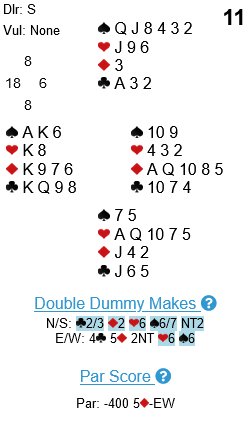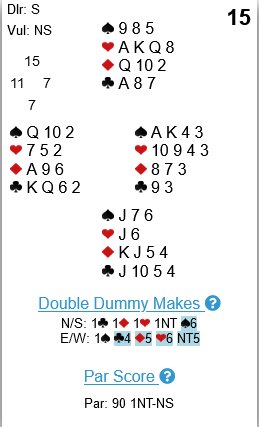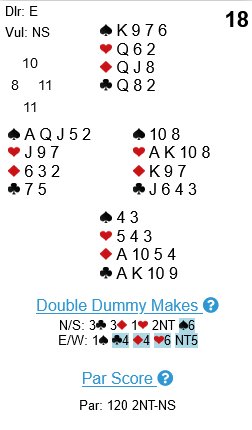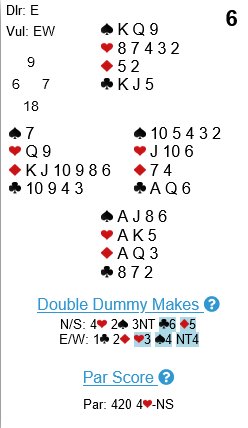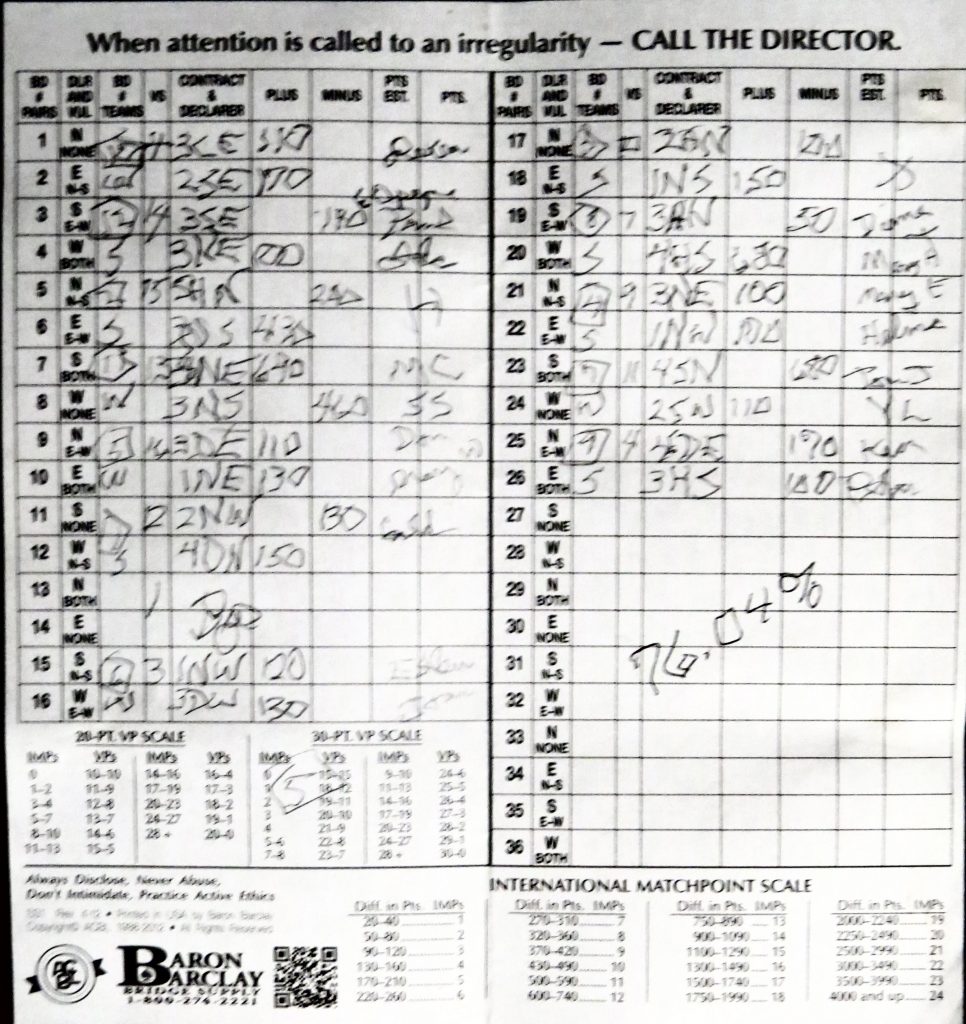76.04%! Continue reading
By August of 2023 I had been playing bridge seriously for over nineteen years. In pairs games I had once or twice recorded scores of a little over 70 percent1, but I had never come close to achieving 75 percent, which was the standard set by The Bridge Bulletin for a “big game”.2
The Hartford Bridge Club had put its Saturday afternoon game on hiatus early in the summer. My partner, Peter Katz, and I were regulars at that game, but by late August we had not played together for more than two months. During the weeks before the hiatus the game had been lucky to draw as many as six pairs, the minimum required for a reasonable game.
The HBC decided to sponsor a special game on August 26, 2023, to see if there was any interest in resuming the Saturday afternoon game. It was a STaC game, which meant that extra points were rewarded, the points were silver (as required for advancements in rank), and the results of our game would be combined with the results of other clubs in District 25 (New England) to determine the “overall” points rewarded.
The event was an unqualified success. A total of fifteen pairs—seven and a half tables—participated. We played a Howell movement that involved fourteen rounds of two boards each using. Most pairs played only thirteen because with an odd number of pairs one pair has a bye each round. In a Howell movement most pairs play North-South on some hands and East-West on others. I played South and West. As it happened, Peter and I had a bye in the very last round.
I drove to the club with my wife Sue. She was playing for the first time with Cecilia Vasel. Because Sue was always late, I spent nearly an hour before we left going over the list of conventions that I had written on a “cheat sheet” that I kept in the yellow convention card holder that contained the card that Peter and I played. It was quite different from what I played with other partners. I suspected that I probably would forget something; I just had to hope that it would not be too damaging.
Quite a few pairs who did not ordinarily play in open games were in attendance. So, the competition was not quite as good as I had come to expect at the Saturday open games.
Peter and I got off to a good start. On our first board, #11, we were sitting North-South. Our opponents stopped in 2NT when almost all of the other pairs with their cards bid 3NT. We can actually take the five tricks needed to hold them to 2NT, but to do so 1) Peter would have needed to lead a heart, and 2) I would have needed to take my ace and then continue with a low heart, and 3) Peter would have needed to save his last heart, and 4) I would have needed to save all of my remaining hearts. No one found that defense.
So we started with five points out of a possible six, which translated to 83.33 percent. If we had found the right combination, it would not have helped us much. In fact, the pair that finished second with a 69.55 percent game, Y.L. Shiue and Tom Joyce, was even luckier than we were in the first round. Their opponents stopped in 3♦ , which gave Y.L. and Tom the top score on the hand.
On Saturday Peter and I were the only pair who played a Weak 1NT system, which meant that we would open any flat3 hand with between 11 and 14 high-card points with a 1NT bid. A good predictor of our likely success in a game was the number of times that we opened 1NT. Sometimes we get no such hands. In this game we got several such opportunities.
On hand #15 I opened 1NT with the West hand after South, the dealer had passed. At the other tables West passed, and North, playing the standard 15-17 point no-trump system, bid 1NT.
The East-West teams that tried to interfere at the two- or three-level in spades or hearts did not do well, but allowing the opponents to play in 1NT was not a winning strategy either.
At our table, North was in a quandary. I would have doubled with her hand, but she elected to pass. Here only good lead was a diamond, but it was tempting lead the ♥A. In the end I scrambled for eight tricks—four spades, a heart, a diamond, and two clubs. We scored 120 matchpoints, which was just enough to edge out Y.L. and Tom, whose opponents (N-S) somehow stumbled into a 2♥ contract.
On hand #18 we were sitting North-South. After two passes I opened my flat eleven-count hand with 1NT, and everyone passed.
At two of the other tables the hand was passed out. Two of the other North-South pairs played 1NT, but North was declarer. One N-S pair played in 2♣. One E-W team was in an insane spade contract that went down by two tricks, but it was not doubled.
The two Norths playing 2NT took the expected eight tricks. I can’t remember how I did it, but I scored nine tricks. The opponents must have helped me, but it is difficult to see how any strategy would have led to such an outcome. I remember feeling stunned at the conclusion.
At any rate the 150 points gave us another top board.
I made a bidding mistake on hand #6. It could have been costly, but it actually worked out very well for us.
We were sitting N-S. After East passed I opened 1♣. I would have overcalled 2♦ with West’s hand, but I think that she passed. Peter bid 1♥.
I should have rebid 2NT (or 1NT if I downgraded my hand to 17 points), but I confused this situation with another. I jumped to 3NT, which ended the bidding. If I had rebid 2NT, Peter would have had the opportunity to show his heart suit,3 and we would have played in the theoretical best contract of 4♥. If I had rebid only 1NT, Peter would have had a difficult time justifying a second bid.
Our actual contract became the best possible when West led the ♦J. This gave me an extra diamond trick to offset the diamond ruff that the players in 4♥ were able to score. So, our 430 was ten points better than two of the pairs that bid 4♥, and one pair somehow went down in that contract.
As Dylan sang in “Idiot Wind”, “I can’t help it if I’m lucky.”
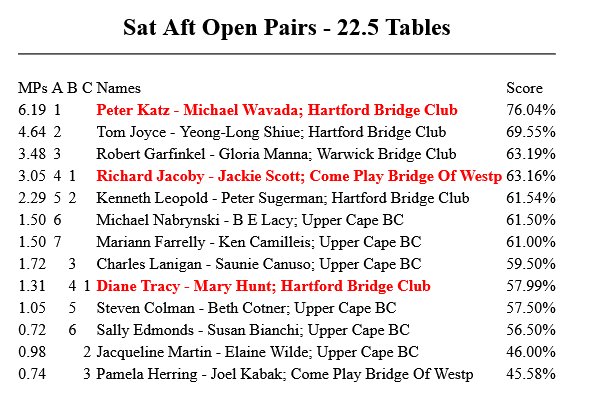
1. In the “matchpoint” scoring that was used in pairs games, the same hand was played by several sets of players. Your score was based on the number of pairs sitting the same direction that you did better than. You get one point for each pair that you beat and 1/2 point for each pair that you tied. Suppose the hand was played by eleven sets of pairs, and you had a better score than two and the same score as four of the other ten pairs. You would get four points (2 x 1 + 4 x 1/2), which would be 40 percent of the total available points (the other ten teams playing in your direction). It should be easy to see that it was quite difficult to score better than 3/4 of the other pairs over the course of at least twenty hands at an open sanctioned game with at least five tables, all of which were required for a “big game”.
2. Unfortunately, our names never appeared in the Bridge Bulletin and asked them why, the response was, “ST@C games are not eligible for Big Games.” When I asked why not, I got back, “I really don’t know! That’s just what the rules say.” Here are the rules as posted in the Bulletin:
Evidently the STaC games are considered sectionals. It is true that they are sectionally rated as far as masterpoints are concerned, and the points are silver, but they are played in regular old clubs with regular old directors, and nobody considers them as equivalent to sectionals in any way.
3.. “Flat” or “balanced” hands have roughly even distributions. Peter and I restricted it to 5-3-3-2, 4-4-3-2, and 4-3-3-3 hands. We never opened 1NT with five spades or hearts.

 2023 August Bridge: The Big Game
2023 August Bridge: The Big Game
